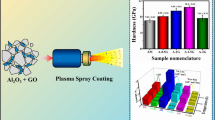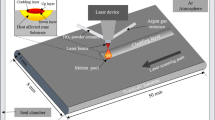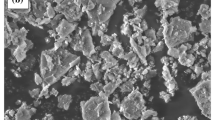Abstract
Thermally sprayed ceramic coatings with varied weight percentages of carbon nanotube (CNT) reinforcement were examined. AISI 1020 steel was coated with yttria-stabilized zirconia (ZrO2 + 8% Y2O3) using the atmospheric plasma spraying (APS) method. The study examined the CNT dispersion in the coating microstructure and evaluated the porosity, bond strength, and corrosion resistance of the coating. In addition, the coating thicknesses were measured. The coatings were characterized using a variety of techniques, including optical microscopy, scanning electron microscopy, image analysis, bond strength testing, and corrosion analysis. According to the findings, adding CNTs to the coatings improved their mechanical characteristics, particularly their hardness and wear resistance. Notably, the best levels of hardness and wear resistance were seen in coatings with a 5 percent CNT reinforcement. Additionally, the coatings' corrosion resistance was enhanced by the inclusion of CNTs. The results of this work show that the mechanical and corrosion properties of thermally sprayed ceramic coatings can be successfully improved by the inclusion of CNTs. This means that these CNT-reinforced coatings have a lot of potential for a variety of applications, such as wear-resistant, corrosion-resistant, and thermal barrier coatings.
















Similar content being viewed by others
Data Availability
All data generated or analyzed during this study are included in this published article.
References
Y. Wang, M. X. Li, H. L. Suo, Surface Engineering, 28, 329 (2012).
Y. Bai, Y. H. Wang, Z. Wang, Q. Q. Fu and Z. H. Han, Surface Engineering, 30, 568 (2014).
D. Ghosh, S. Das, H. Roy and S. K. Mitra, Surface Engineering, 34, 22 (2018).
R Liu and L Shi, Surface Engineering, 29, 700 (2013).
Q.-Y. Chen, C.-X. Li, J.-Z. Zhao, G.-J. Yang and C.-J. Li, Materials and Manufacturing Processes, 31, 1183 (2016).
J. R. Vargas Garcia and T. Goto, Science and Technology of Advanced Materials, 4, 397 (2003).
M. Góral, R. Swadźba, T. Kubaszek, Surface and Coatings Technology, 395 (2020).
M. Adam Khan, S. Sundarrajan and S. Natarajan, Materials at High Temperatures (2016).
A. K. M. Basha, S. Srinivasan and N. Srinivasan, International Journal of Minerals, Metallurgy and Materials, 24, 681 (2017).
T. Nakamura, G. Qian and C. C. Berndt, J. Am. Ceram. Soc. 83, 578 (2000).
X. Li, X. Yin, L. Zhang, T. Pan, Materials Science and Engineering: A, 527, 103 (2009).
R. Goyal, K. Goyal, Electrodeposition and coatings, 12 (2022).
K. Goyal, H. Singh and R. Bhatia, Materials Research Express, 5 (2018)
K. Goyal, H. Singh and R. Bhatia, Anti-Corrosion Methods and Materials, 65, 646 (2018). https://doi.org/10.1108/ACMM-06-2018-1954.
H. Jamali, R. Mozafarinia, R. S. Razavi, R. A. Pidani, Advanced Materials Research, 472–475, 246 (2012).
F. Chang, K. Zhou, X. Tong, L. Xu, X. Zhang, M. Liu, Applied Surface Science, 317, 598 (2014).
K. A. Khor, Y. Li, Mater Lett, 48, 57 (2001). https://doi.org/10.1016/S0167-577X(00)00280-9.
Acknowledgements
Not applicable.
Funding
The authors declare that no funds, grants, or other support were received during the preparation of this manuscript.
Author information
Authors and Affiliations
Contributions
All authors contributed to the study conception and design. Material preparation, data collection, and analysis were performed by CK and MRV. The first draft of the manuscript was written by CK, and all authors commented on the previous versions of the manuscript. All authors read and approved the final manuscript.
Corresponding author
Ethics declarations
Conflict of Interest
The authors declare that they have no known competing financial interest or personal relationships that could have appeared to influence the work reported in this paper.
Consent to Participate
All authors happily agree to participate in this research study.
Consent for Publication
All authors give the permission to the journal to publish this research study.
Ethical Approval
The paper is not submitted to any other journal.
Additional information
Publisher's Note
Springer Nature remains neutral with regard to jurisdictional claims in published maps and institutional affiliations.
Rights and permissions
Springer Nature or its licensor (e.g. a society or other partner) holds exclusive rights to this article under a publishing agreement with the author(s) or other rightsholder(s); author self-archiving of the accepted manuscript version of this article is solely governed by the terms of such publishing agreement and applicable law.
About this article
Cite this article
Kalangi, C., Veeram, M.R. Mechanical and Electrochemical Behavior of CNT-Reinforced YSZ Coating. High Temperature Corrosion of mater. 101, 309–330 (2024). https://doi.org/10.1007/s11085-024-10223-4
Received:
Revised:
Accepted:
Published:
Issue Date:
DOI: https://doi.org/10.1007/s11085-024-10223-4




